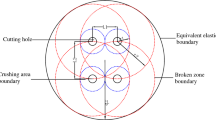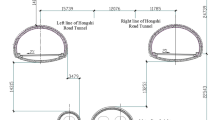Abstract
Cost-effective tunnel excavation can be achieved with the blasting method. Unfortunately, blasting technique brings with it blastinginduced vibration and noise, which can cause critical social problems such as public complaints. Thus, the development of a novel tunnel excavation method, one that can reduce the blasting-induced vibration, is strongly demanded for the effective management of urban spaces. Thus, this study introduces an innovative vibration-reduced excavation method that combines the conventional blasting technique with the precutting process and carries out a feasibility study of the proposed tunnel excavation method using three-dimensional finite element analyses. The micro-scale study focuses on the stopping holes and contour holes while the macro-scale study deals with the case of a real scale tunnel. From the micro-scale analyses, it can be deduced that the proposed method is effective for the reduction of blasting-induced vibration compared to the conventional line-drilling method. From the macro-scale simulation, it is found that the reduction of blasting-induced vibration is independent of the thickness of the precutting free surface but dependent on the depth of the precutting free surface. As the depth of the precutting free surface increases, blasting-induced vibrations as well as the depth of the excavation-damaged zone can be significantly reduced. Vibration energy induced by blasting does not transmit through the free surface and is trapped inside the target tunnel face. Guided blasting waves cause stress concentration at the target face and maximize the blasting efficiency. It is expected that the construction cost will decrease due to a decrease in the number of drilling holes, the weight of the explosive charges, the overbreak space, and the excavation-damaged zone. In particular, the reductions of the overbreak space and excavation-damaged zone enhance the safety of tunnel construction.
Similar content being viewed by others
References
Chollette, D., Clark G. B., and Lehnhoff, T. F. (1976). “Fracture stresses induced by rock splitters.” International Journal of Rock Mechanics and Mining Sciences & Geomechanics Abstracts, Vol. 13, No. 10, pp. 281–287.
Dey, K. (2004). Investigation of blast-induced rock damage and development of predictive models in horizontal drivages. PhD Thesis, ISM, Dhanbad.
Dudoladov, L. S. (2006). “Thermal rock breaking.” Journal of Mining Science, Vol. 5, No. 2, pp. 194–198.
Histake, M., Sakurai, S., Ito, T., and Kobayashi, Y. (1983). “Analytical contribution to tunnel behavior caused by blasting.” Proc. of 5 th International Congress on Rock Mechanics, Melbourne, pp. E191–E194.
Holmberg, R. and Persson, P. A. (1979). “Swedish approach to contour blasting.” Proc. of 4th Conference on explosive and blasting techniques, pp. 113–127.
Howie, J. A. and Amini, A. (2005). “Numerical simulation of seismic cone signals.” Canadian Geotechnical Journal, Vol. 42, No. 2, pp. 574–586.
International conference of building officials (1997). Uniform building code.
Jeng, F. S., Huang, T. H., and Hilmersson, S. (2004). “New development of waterjet technology for tunnel excavation purposes.” Tunnelling and Underground Space Technology, Vol. 19, pp. 438–439.
Konya, C. J. and Walter, E. J. (1991). Rock blasting and overbreak control, FHWA-HI-92-001, National Highway Institute.
Lee, I. M., Yoon, H. J., Lee, H. J., Lee, S. D., and Park, B. K. (2003). “Tunnel stability assessment considering rock damage from blasting near to excavation line.” Journal of the Korean Geotechnical Society, Vol. 19, No. 4, pp. 167–178. (in Korean)
Lisitsyn, I. V., Inoue, H., Katsuki, S., and Akiyama, H. (1999). “Use of inductive energy storage for electric pulse destruction of solid materials.” IEEE Transactions on Dielectrics and Electrical Insulation, Vol. 6, No. 1, pp. 105–108.
Lysmer, J. and Waas, G. (1972). “Shear waves in plane infinite structures.” Journal of the Engineering Mechanics Division, ASCE, Vol. 98, No. EM1, pp. 85–105.
MIDAS-GTS (2005). Geotechnical & tunnel analysis system, MIDAS Information Technology Co., Ltd.
Momber, A. W. and Kovacevic, R. (1997). “Test parameter analysis in abrasive water jet cutting of rocklike materials.” International Journal of Rock Mechanics and Mining Sciences, Vol. 34, No. 1, pp. 17–25.
Oh, T. M. and Cho, G. C. (2012). “Effect of abrasive waterjet parameters on rock removal.” Journal of Korean Tunnelling and Underground Space Association, Vol. 14, No. 4, pp. 421–435.
Park, D., Jeon, B., and Jeon, S. (2009). “A numerical study on the screening of blast-induced waves for reducing ground vibration.” Rock Mechanics and Rock Engineering, Vol. 42, No. 3, pp. 449–473.
Parsakhoo, A. and Lotfalian, M. (2009). “Demolition agent selection for rock breaking in mountain region of hyrcanian forests.” Research Journal of Environmental Science, Vol. 3, No. 3, pp. 384–391.
Res, J., Wladzielczyk, K., and Ghose, A. K. (2003). Environment-friendly techniques of rock breaking, A.A. Balkema, India.
Rustan, L. N. (1985). “Controlled blasting in hard intense jointed rock in tunnels.” CIM Bulletin, Dec., Vol. 78, No. 884, pp. 63–68.
Shao, P., Sheng, P., Zhou, J. S., Long, J. K., and Wu, Y. Q. (2010). “Applying high voltage pulse discharge in rock blasting: Theoretical problems.” Proc. of 2nd International Conference on Computer Engineering and Technology, ICCET, Vol. 5, pp. 349–353.
Song, K. I., and Cho, G. C. (2010). “Numerical simulation of the impactecho method for the bonding state evaluation of tunnel shotcrete.” International Journal of Rock Mechanics and Mining Sciences, Vol. 47, No. 8, pp. 1274–1288.
Song, K. I., Jung, S. H., Cho, G. C., and Lee, J. H. (2010). “Seismic Analysis of tunnel considering the strain-dependent shear modulus and damping ratio of a jointed rock mass.” Journal of Korean Tunnelling and Underground Space Association, Vol. 12, No. 4, pp. 295–306.
Starfield, A. M., and Pugliese, J. M. (1968). “Compression waves generated in rock by cylindrical explosive charges, A comparison between a computer model and field measurement.” International Journal of Rock Mechanics and Mining Sciences & Geomechanics Abstracts, Vol. 5, No. 1, pp. 65–77.
Uysal, O., Erarslan, K., Cebi, M. A., and Akcakoca, H. (2008). “Effect of barrier holes on blast induced vibration.” International Journal of Rock Mechanics and Mining Sciences, Vol. 45, No. 5, pp. 712–719.
Zhongzhe, J., Hong, L., and Wen, Z. (1988). “Splitting mechanism of rock and concrete under expansive pressure.” Proc. of 2nd international RILEM Symposium: Demolition and reuse of concrete and masonry, Chapman and Hall, New York, N.Y., pp. 141–148.
Author information
Authors and Affiliations
Corresponding author
Rights and permissions
About this article
Cite this article
Song, KI., Oh, TM. & Cho, GC. Precutting of tunnel perimeter for reducing blasting-induced vibration and damaged zone — numerical analysis. KSCE J Civ Eng 18, 1165–1175 (2014). https://doi.org/10.1007/s12205-014-0393-6
Received:
Accepted:
Published:
Issue Date:
DOI: https://doi.org/10.1007/s12205-014-0393-6




